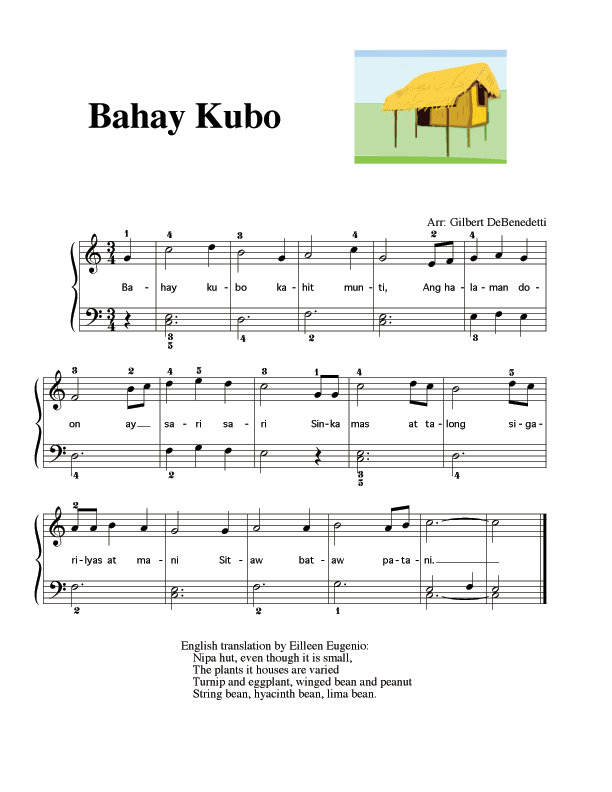Bahay Kubo Characteristics Relation To Place Of Origin
The bahay kubo was typically built with local resources like wood or bamboo and they were kept off the ground with the use of stilts. The word Bahay means House and Kubo means hut it literally translates as Cubed House.
28112019 One significant relic is the Bahay Kubo known to others as the Hut House or Nipa Hut.
Bahay kubo characteristics relation to place of origin. The nipa hut or bahay kubo is a type of stilt house indigenous to the cultures of the Philippines. Music characteristics relation to place of origin of bahay kubo - 4651339 zacruz1508 zacruz1508 15102020 Music Senior High School answered Music characteristics relation to place of origin of bahay kubo 1 See answer english pls ok. Thats why in this article we are going to talk about Filipino Folk Songs.
It is also known as payag or kamalig in other languages of the Philippines. 15092014 GENERAL CHARACTERISTICS Ethnic structures have similar characteristics as of the other countries in Southeast Asia wherein they use pile-construction hip or gable roof and the use wood vegetation and mud. These abodes can range from the hut-style bahay kubo which utilizes vernacular mediums in.
The bahay kubo was the standard structure used for homes in the Philippines before the Spaniards arrived. What is place of origin of bahay kubo. Who composed bahay kubo song.
A notable poetry duel in the Philippines is Balagtasan which is a debate done in verses. Or nipa hut and goes on to tell about the wide variety of vegetables planted nearby. 12012021 Bahay kubo musical characteristics relation to place of origin 1 See answer Ang haba namn yan boiyo boiyo Answer.
Made of indigenous building materials like bamboo and nipa this pre- Hispanic architecture was constructed to perfectly adapt to the tropical climate of the Philippines and to be easily repaired or rebuilt once damaged by. 06022018 We dont have a collective identity Jason Buensalido says. Although there is no strict definition of the Bahay Kubo and styles of construction vary throughout the Philippine archipelago It is originally and is still typical today for Bahay kubo to be mostly organic in material and be elevated mainly for Vernacular and Superstitious reasons and because of floods during wet season and the hot dry land during summer can cause a lot of problems for the.
26062020 Bahay kubo kahit munti Nipa hut though small Ang halaman doon ay sari-sari. It is well known by Filipinos of all ages. Bahay Kubo is a Philippine folk song that originated in the Philippines.
By tradition this type of village dwelling is constructed out of organic materials a perfect. It cam also be written on bamboo. The name comes from when American teachers went to.
In 1924 it was included in a collection of Filipino folk songs compiled by Emilia S. 21042010 The Bahay Kubo is one of the most illustrative and recognized icons of the Philippines. Cube House in English a house made of bamboo with a roof of nipa leaves surrounded by different kind of vegetables and is usually sang by Filipino school children.
The traditional bahay kubo follows the centuries-old Southeast Asian rural archetype of the single-room dwelling where all family activities happen in one space. A bahay kubo also known as a NIPA hut is a type of stilt house home to the cultures of the Philippines. The place where something is made or created The wine is named for its place of origin.
Its architectural principles gave way to many of Filipino traditional houses and buildings that rose after the pre-colonial era. Bahay Kubo is a traditional Tagalog Filipino folk song credited to have been written by 1997 National Artist for Music Felipe Padilla de Len bahay kubo was usually sang by Filipino school children and as familiar as the Alphabet Song and Twinkle Twinkle Little Star of the west. The name of the primitive Nipa hut is actually based on the Spanish phrase Cubo meaning cube probably because of its rectangular appearance and Bahay is the Filipino word for house.
The song is about a bahay kubo lit. Bahay Kubo Nipa Hut Bahay kubo kahit munti Ang halaman doon ay sari-sari. They are a brown-skinned slim and straight-haired ethnic group.
After sleeping mats are rolled up in the mornings the same space is given over to daytime activities that sometimes spill outdoors to the shaded areas underneath the house. The Tagbanwa people Tagbanwa. 28092020 Musical characteristics relation to place of origin of bahay kubo.
It is surrounded by various plants Singkamas at talong sigarilyas. Is a traditional Tagalog-language folk song from the lowlands of Luzon Philippines. By tradition this type of village dwelling is constructed out of organic materials a perfect example of a totally green.
Liberally using poetic language certain situations or certain characteristics referred to by the one reciting the poem. The Philippines has a rich architecture history which traces its roots to the traditional bahay kubo a house on stilts.
These include the Colonial era bahay na bato which is a noble version of bahay kubo with Spanish and some Chinese main architectural influenc. Some notable poems include A la juventud filipina. A typical bahay kubo from the countryside made of nipa and bamboo The Bahay Kubo is the native house of the Philippines and is also considered as its national shelter.
Many are aware of the house types name by heart thanks to the old folk song titled after it. Bahay Kubo Credited to have been written by composer and 1997 National Artist for Music Felipe de Leon 1912-1992 it tells of the typical Filipino rural house the standard bahay kubo. 09112017 The term bahay kubo comes from the Filipino language translating to house cube.
The rural bahay kubo evolved into the bahay na bato.

